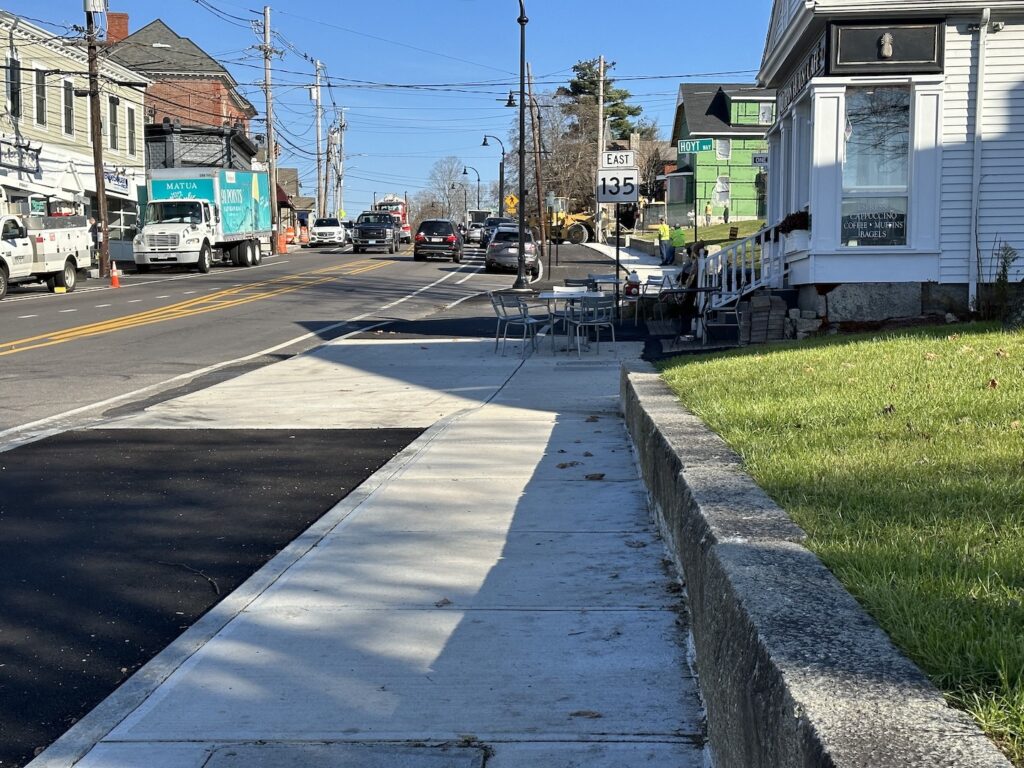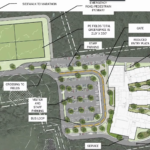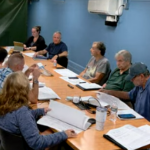
The bike lane on Main Street has faced criticism from bicycle advocates for safety reasons as well as motorists who complain it has narrowed the road too much. PHOTO/JERRY SPAR
Cycling advocates raised concerns about the safety of the separated bike lane implemented as part of the Main Street Corridor Project, hoping that modifications will be handled when construction resumes in the spring.
Construction halted for the winter on the Main Street Corridor Project in early November, with final paving and brickwork to resume in the spring. No ending date has been set for the project, according to the town website. The town is awaiting transformers from Eversource in order to complete underground utility work.
Cyclist’s history of bike safety advocacy inspired by his past
Resident Ed Harrow described himself as “a third-generation, hardcore biker.” His passion for cycling was inspired by his parents, who met while riding bicycles at the Gettysburg National Military Park in Pennsylvania in 1942. His uncle owned a bike shop in Massachusetts. He also referenced a picture of his great-great grandaunt and granduncle riding a tandem tricycle in New York in the 1890s.
There also is a tragic side to his passion for cyclist safety, he explained.
“My brother was killed by a left-turning motorist,” he said. “That is what is called inattentional blindness.”
He stressed that motorists and pedestrians are always taught to look both ways for cars, but bicycles are never mentioned.
Harrow worked in the bicycle industry for 10 years, traveling around the country as well as Europe and Australia promoting cycling safety. He warned of potential problems with the bike lane in a presentation he gave at the Special Town Meeting on Dec 9, 2019.
Although Town Meeting approved the project in May 2018, an opposition group called the Main Street Alliance petitioned for a Special Town Meeting to voice concerns about the project and the easements required for it. Special Town Meeting ultimately voted to continue with the Main Street Corridor Project by defeating the article in a 504-278 vote.
Harrow shared information from a guide published by the American Association of State Highway and Transportation Officials (AASHTO) regarding bike lane specifications. He also noted that the lead author of the state’s planning design guide for separated bike lanes is VHB, the engineering firm that was used for the Main Street Corridor Project.
According to the MassDOT website, VHB has worked with MassDOT on dozens of reports on all aspects of road safety. VHB analyzes data provided by MassDOT to help develop safety performance structure guidelines and manuals.
“In my humble opinion, what has been done on the bike lane disagrees with what they have published in the Massachusetts planning and design guide,” said Harrow. “For example, they want a two-way bike lane to be 10 feet wide, but 9 feet is acceptable in some circumstances. I measured one spot that was a bit more than 8 feet.”
During a Nov. 20 midday walk along Main Street, Harrow pointed out some of the problems he has found with the bike lane. Most notably, he said there are 22 curb cuts that allow vehicles to cross the bike lane. Storm drain grates also can cause problems for bikers. According to MassDOT guidelines, it is best to limit curb cuts, storm drains and manhole covers in bike lanes.
Harrow also pointed out that there are 32 metal surfaces in the bike lane, not including the metal poles. The most dangerous ones for bikers are what he described as “17 ninja turtle covers.”
Another issue Harrow had was with the pole in front of Town Hall. The standards were unclear as to whether regulations allow the pole to be 18 inches away from the bike lane or 18 inches into it.
Cycling instructor discusses concerns
A pole in a bike lane creates hazards for bikers, according to certified bicycling instructor John S. Allen. He authors a blog where he chronicles issues with bike lanes across the country.
“I looked at the area before the bike lane was constructed,” Allen explained in a recent phone interview with the Independent, noting he attended a Main Street Alliance meeting. “I looked at the plans.
“This is the poster child for how to make bike lanes hazardous,” he continued. “There are questions about its slope and width, especially with a two-way lane. It will generally be too narrow to pass in one direction with people going in the other.”
The topography of the road contributes to bike lane issues, according to Allen. While a biker can go 3 mph uphill, speeds going downhill can be up to 10 times as fast. Combined with the number of driveways on Main Street, that can lead to a situation where a bicyclist may collide with a vehicle.
“It’s not safe for children or novice cyclists,” he said. “There are crossing and turning conflicts.”
Allen concluded: “There is really no way Main Street could be made nice for cycling.”
Resident calls Main Street Corridor project ‘a mess’
Resident Peter LaGoy expressed concerns about the Main Street Corridor design in a recent email to the Independent.
“Put simply, this is a mess,” he stressed. “The intersection was not a problem in the past, but with the changes, most notably the Hayden Rowe lane narrowing as it approaches Main, this has become a serious problem. There’s a pole suggesting that a fix, in the form of a traffic light, is planned, but even that won’t correct all the issues.”
One recent Saturday, he witnessed two tractor-trailers trying to make a right-hand turn onto Main Street.
“The truck had to be in the left-turn lane to start,” he explained of the first vehicle. “And even from that starting point, it still had to drive in the westbound turn lane from Main Street to Hayden Rowe. It makes no sense.”
He stated that “a larger than necessary grass and asphalt buffer” could be replaced with pavement to ease turn navigation.
Regarding the bike lane, LaGoy noted that while visibility at that intersection previously was problematic, the width of the bike lane at that intersection makes it even worse. He pointed out that the rest of the bike lane on Main Street is 10 feet, while this portion appears to be 15 feet.
“There seems no apparent reason for this excess width at this point,” he continued. “The sidewalk here is doubled, so it’s wider than elsewhere as well, meaning we’re left with a very wide path of concrete and asphalt, with little obvious purpose.”
Town responds to concerns
Michelle Murdock, the town’s professional project specialist on the Main Street Corridor Project, addressed some of the concerns voiced by residents in an email to the Independent on Nov. 28.
“The bike lane was designed by a VHB bicycle specialist, reviewed and fully vetted by MassDOT,” she stated. “Regarding the remaining work on the bike lane, line striping will be done in the spring and bike lane signs are currently being evaluated/finalized — to read ‘Two-Way Bike Traffic’ and are planned to be placed this year.”
She added that a MassDOT public hearing on the project was held on Jan. 9, 2018, when information was provided and comments were heard from residents. Also, a bike lane discussion was held on Sept. 17, 2019.
On a related note, on Nov. 30, Murdock released a statement that VHB will be conducting a traffic study on Main Street after receiving public feedback regarding the timing of traffic signals and the amount of traffic using side streets. Traffic counts were to be collected from 7 a.m.-7 p.m. on Dec. 7 at Wood Street, Pleasant Street, Cedar Street and Hayden Rowe, all intersecting Main Street.
“The counts will be used to evaluate operations, signal timings, and to review traffic patterns and volume,” the release stated. “Once reviewed, this data will be used to determine if any adjustments or further actions are needed.”






















Keeping the Main Street project alive for another two years is an excellent opportunity to perform the “evaluation of operations and signal timings and to review traffic patterns and volume” (per Michelle Murdock, the town’s professional project specialist on the Main Street Corridor Project) after the project is completed. Silly me: Why would anyone need or want to perform any evaluation/ preplanning of the Main Street project before construction starts?
I’ve been cycling on all the roads in Hopkinton and neighboring towns since I moved here is 2005.
These cycling lanes are clearly a mistake, a poor decision in order to attain funds for the downtown corridor project.
This particular design has been used in only a few instances in other towns because it’s poor design has caused accidents and those towns were forced to spend more money to re-design and fabricate their bike lanes.
Hopkinton would serve it’s town and citizens well by modifying these bike lanes before this happens.
And if it isn’t obvious to the non-cyclist residents in town, every road cyclist living in or near Hopkinton will never ride on these lanes because of the many dangers they pose and will be riding on the roads if they decide to use West Main Street.
My comments have been submitted for publication. I trust they will be up for reading, soon.
The reason the bike lane is only 8 feet in some areas is because the people “with the big brains” didn’t take into consideration of the emergency vehicles that have to get through the traffic, those lanes could have been painted on each side of the road and it would have wide enough to accommodate everyone and everything. Can’t wait to when it has to be removed and something else has to done….
I really question this statement: “The bike lane was designed by a VHB bicycle specialist”
I have to wonder about the experience of this bicycle specialist especially when I read the comments from people with real experience like Ed Harrow, John Allen and Peter LaGoy. Throughout the whole project, these people have expressed their concerns, to no avail.
Anybody can call themselves a bicycle specialist, even an intern. What other projects has this bicycle specialist also designed?